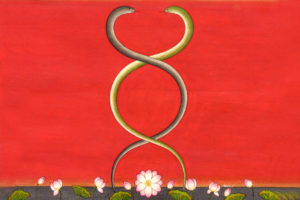 Kundalini yoga came into my life by chance when I was travelling through India working as a photographer. I met my first Kundalini yoga teacher whilst I was making portraits of nomads in the Gujarati desert in 1995 and Guru Kaur and her husband climbed into the truck that was carrying me and a bunch of nomads off to the Rann of Kutch. I had not seen a white skinned person for several months and was surprised when I heard that she was a stockbroker and he worked as a secret policeman. After many conversations I discovered that when Guru Kaur wasn’t working as a stockbroker she taught yoga. And when I returned to London I started a Kundalini class with her at 6.30am on a Saturday morning and was gradually seduced by a practice which, at first, I hated!
Kundalini yoga came into my life by chance when I was travelling through India working as a photographer. I met my first Kundalini yoga teacher whilst I was making portraits of nomads in the Gujarati desert in 1995 and Guru Kaur and her husband climbed into the truck that was carrying me and a bunch of nomads off to the Rann of Kutch. I had not seen a white skinned person for several months and was surprised when I heard that she was a stockbroker and he worked as a secret policeman. After many conversations I discovered that when Guru Kaur wasn’t working as a stockbroker she taught yoga. And when I returned to London I started a Kundalini class with her at 6.30am on a Saturday morning and was gradually seduced by a practice which, at first, I hated!
It soon became part of my daily ritual, and I have been teaching since 1998 and I can honestly say that my experience of playing with the Kundalini continues to expand beyond my expectations.
Kundalini, in Hinduism refers to a form of primal energy said to be located at the base of the spine. In the Hindu tradition, Bhairavi is the goddess of Kundalini.
A class is generally an uplifting blend of spiritual and physical practices, Kundalini Yoga incorporates movement, dynamic breathing techniques, meditation, and the chanting of mantras.
The goal is to build physical vitality and increase consciousness, awareness and to enable the practitioner to expand their deepest sense of themselves.
What is this potency?
Kundalini yoga differs from most other practices in that it allows you to literally play with intention. Our intention is profound and potent. It is quantum physics made manifest and when we actively engage with the power of our intention, we can create personal change. By contrast, if we are not consciously and actively engaged in the power of our intention we are constantly inviting the energy to follow our negative and highly repetitive anxious thought patterns: I am tired, I can’t do this, I am lonely, etc.
My awareness is that this aspect of how Kundalini is taught makes it so wonderfully potent; we are invited and supported to transform, to work towards our better or ideal version of ourselves. It can enable you to mature out of childish emotional patterns into a clearer and more adult version of ourselves.
The postures, mantras and meditations all support this, and progress can be fast in terms of strengthening the self, the nervous system and holding the mentalization, or visualising the intentions.
This yoga style works really well for those addictive natures, anxiety sufferers, working through trauma, healing anger and low self esteem issues. Personally I have also found it very helpful when working with the huge range of issues that rise in menopause.
Each teacher works with the Kundalini energy differently. We are all invited to bring ourselves into the teaching process and therefore every class has its own flavour. Some teachers are manifestly Sikh, follow these teachings and view the energy through this lens. Others of us take a wider perspective and hold space where the individual can finding their own internal connections and “spiritual practice”.
Over the 25 years or so I have been playing with this force I can see continuous change, evolution, transformation and growth, within myself and around me. This is what holds me to the path. There are certain postures, breaths, meditations and concepts which have become essential, life-enhancing, pivotal and without which I would not hold myself so well in these swirling and chaotic times.
We have several postures in this discipline which really do create instantaneous shifts in the body energy. I show a few here that work on the Vagus nerve, the fascia and are also grounding and heart-opening. You could play with any of these postures for 3 minutes a day for 40 days and see how they create transformation over the weeks alongside their ability to effect immediate resetting of the internal sense of self.
It is best to wear loose comfortable clothes, and to actively decide to tune into yourself before starting. Traditionally we use a mantra “ong namo guru dev namo”, (I bow to the Divine within), repeated three times. I always feel that postures are more potent when done with the eyes closed, moving slowly, inhaling when the lungs are stretched and exhaling when compressed.
1. Miracle Bends. Called so because of their transformational nature.
Stand with feet comfortably apart. Inhale arms high up above the head, slightly leaning back, chin raised. And exhale arms down, hands past your now bent knees, and continue, inhaling up and down.
This posture, on the inhale up, opens the heart energy, expands the lungs, stretches the Vagus nerve and the fascial bridges.
On the exhale arms lowering, stretches the spinal nervous system and compresses the internal organs, relaxing them and stimulating positive, feel-good hormones to flow.
It is also said to expand the electro-magnetic field. Excellent when you feel flat, low or stressed.
2. Sufi Grind. This is an exquisite posture. Very sensual, hypnotic, when done slowly and with a deep intention to allow the belly button to explore a hemispherical voyage around the equator of your torso.
To start, sit cross legged, hands over your knees. With your eyes closed, pull your chest forward and raise your chin as you inhale. From her begin to allow the spine to move to one side as you allow yourself to tip onto the back of your pelvis into a deep slouch. Continue the journey round until you are again inhaling and pulling over the chest and the neck. Generally I would say 3 minutes, one minute one way, change direction for another minute then 30 seconds and thirty seconds both ways.
This posture massages the internal organs and releases seratonin into the body. Sit with eyes closed breathing gently when finished, allowing the brain to gather the seratonin. The sensation is one of utter stillness.
3. Cobra. Lying on the stomach, if not very flexible, hands infant of your shoulders. If feeling soft and fluid, hands under the shoulders. Eyes closed, inhale up keeping the shoulders down and the elbows soft, stretch the chin up. Exhale down. Continue for 2 minutes.
This posture is profoundly relaxing for the fascia, it stretches the Vagus Nerve and releases contraction around the heart and lowers anxiety. Lie still after and be soft. Let your body experience itself in a relaxed state. This one is great to do in bed if you cannot sleep!

